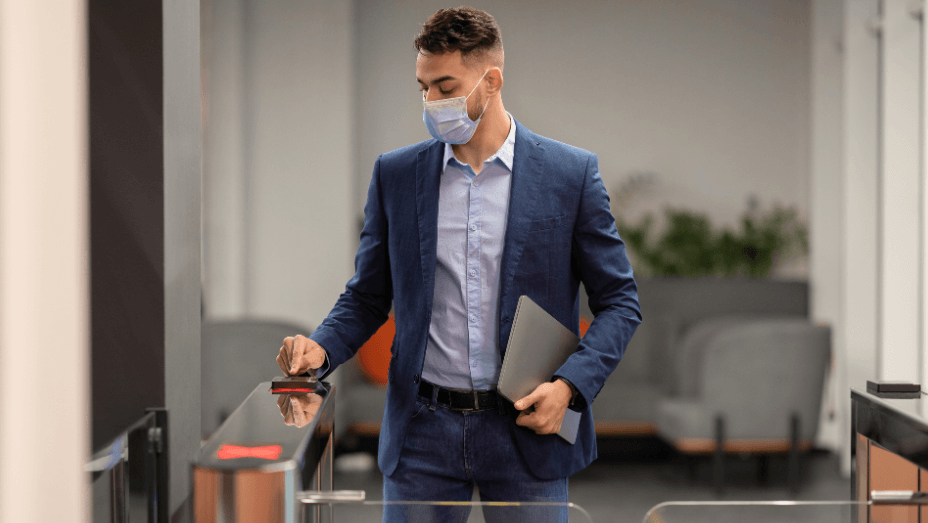In today's digital world, the prevailing threats aren't limited solely to tangible concerns. Dangers lurking behind screens are equally alarming, if not more so. Therefore, it becomes crucial for any office setting to reevaluate its security measures regularly and keep up-to-date with the continually advancing technology. To be unprepared is a risk you can't afford in this sophisticated era of information and technology.
In this article, we aim to shed light on the importance of office security and provide you with expert tips and valuable tools that every secure workplace should consider implementing. We'll begin by understanding what office security truly entails.
TL;DR:
- Office security extends beyond physical safety, encompassing data protection and cybersecurity in today's digital era.
- Physical safety measures include surveillance cameras, controlled access systems, and security plans, reducing violent incidents by nearly 60%.
- Data protection is crucial for safeguarding sensitive information, involving secure practices like restricted access and encryption techniques.
- Cybersecurity is a rising concern, addressing threats like phishing and viruses that exploit network vulnerabilities.
- Implementing comprehensive office security measures enhances compliance with regulations and industry standards.
- Benefits of office security measures include protection against theft, vandalism, and maintaining stakeholder confidence.
- Access control systems, surveillance cameras, and visitor management procedures are key components in improving office security.
- Effective visitor management includes digital registration processes, technology integration, and clear guest access policies.
- Cybersecurity best practices involve strong password policies, employee education on phishing and malware, and regular software updates.
- Emergency response plans, including evacuation procedures, contact protocols, and employee training, are vital for maintaining safety during unforeseen events in the workplace.
Understanding Office Security
What is office security? Well, office security isn't just about safeguarding doors, windows, or assets - as many of us often misconceive it to be; instead, it spans a broader range addressing physical safety, data protection, and cybersecurity. Essentially, it's a holistic approach to creating a safe work environment.
Firstly, let's address security in the office in terms of physical safety. This includes protection against potential dangers such as theft or vandalism, which can disrupt day-to-day operations significantly while leading to massive monetary losses. It requires setting up systems that control access into your premises along with surveillance cameras monitoring activity during work hours or otherwise.
Secondly, data is probably your most valuable asset – one whose loss could immediately lead to an abyss of irreparable damage both reputationally and financially. Protecting sensitive data thus forms a critical part of secure workplaces.
Last but no less significant comes cybersecurity – something intrinsically tied up with data protection but warranting separate mention given its rising importance in today's evolving technological landscape. Cybersecurity involves being alert against phishers eyeing your network vulnerabilities or viruses and planning malicious attack paths into your system networks.
The call remains, therefore, for activating a robust office security system encompassing these pillars, ensuring you stay ahead of the curve and promoting a secure office environment.
Key Components of Effective Office Security
Effective office security is built on a foundation of interconnected components that work harmoniously to mitigate risks and create a secure environment. Let's explore the essential elements contributing to a robust office security strategy.
Physical Security Measures
Physical security measures form the first line of defense against unauthorized access and potential threats. These measures often involve tangible barriers and systems that deter intrusion. Here are some key aspects of physical office security:
- Access Control: Implementing access control systems, such as keycard entries, biometric scanners, or security personnel, restricts entry to authorized individuals, preventing unauthorized access to sensitive areas within the workplace. Limiting access to specific personnel adds an extra layer of protection against potential threats.
- Surveillance Systems: A robust surveillance system acts as a deterrent and provides valuable evidence in case of security incidents. Strategically positioned CCTV cameras throughout the office premises can monitor activity, record incidents, and assist in investigations.
- Security Personnel: Employing trained security personnel can bolster your office's security posture. Security guards can monitor entrances, patrol the premises, respond to incidents, and enforce security protocols, adding a human element to your security strategy.
Cybersecurity Measures
In today's digital age, cybersecurity is paramount. Protecting sensitive data, communication networks, and digital assets is essential for maintaining business continuity and safeguarding your company's reputation. Here are vital aspects of cybersecurity in the office:
- Network Security: A secure network infrastructure prevents unauthorized access, data breaches, and cyberattacks. Implementing firewalls, intrusion detection systems, and virtual private networks (VPNs) are essential to securing your network.
- Data Protection: Safeguarding sensitive information is critical. Encryption, data backups, and access controls prevent breaches and ensure data integrity. Multi-factor authentication adds an extra layer of security to user accounts, making it harder for unauthorized individuals to gain access.
- Employee Training: Educating employees about cybersecurity best practices is vital in mitigating human error, which is often a leading cause of security breaches. Regularly training employees on password hygiene, phishing scams, and social engineering tactics can enhance cybersecurity awareness and reduce the risk of successful attacks.

Benefits of Implementing Office Security Measures
Office security is not simply about locking doors or installing alarm systems. It's a comprehensive approach that involves numerous elements, all aimed at shielding your workplace from potential threats. Here's why businesses need to invest in securing their workplaces.
Protecting the Physical Safety of Employees and Visitors
Let’s start with the most fundamental aspect: physical safety. Enhancing office security offers the utmost protection for everyone within the premises - employees and visitors alike. Gone are days when an unlocked door could be overlooked. In modern times, secure workplace measures guard against intruders and individuals threatening physical safety.
In fact, according to the National Institute for Occupational Safety and Health (NIOSH), workplaces with engaged security plans establish a safer environment, reducing violent incidents by nearly 60%. So remember, employees working under secure conditions perform better as they are free from fear and anxiety related to potential threats.
Preventing Theft and Vandalism
Secondly, vandalism can inflict economic and aesthetical damage on your office resources, which may lead to further costs associated with repairs or replacements. Deploying advanced office security methods significantly reduces incidents of vandalism – strategic deployment of CCTV surveillance cameras intimidates would-be vandals, for example.
Theft is another area where effective workplace security measures shine bright. Whether you’re worried about burglary or internal theft by unscrupulous employees – high-precision CCTV cameras will undoubtedly deter thieves in most cases.
Safeguarding Sensitive Data and Information
Data is often overshadowed by physical threats—the lifeblood of any modern organization. Confidential customer information, sensitive employee details, proprietary company data—all could be devastating if they fell into the wrong hands.
Effective office security protocols protect this precious entity in physical form, like documents and digital formats. For instance, utilizing secure office practices, including restricted access to data centers or employing encryption techniques for digital assets, adds formidable layers of protection around your data.
Maintaining Compliance with Regulations and Standards
Finally, robust security in the office facilitates compliance with industry standards and regulations. Businesses often need to abide by specific rules regarding data protection (like GDPR), building codes, and health and safety guidelines—failing could lead to hefty penalties and even license revocation under extreme circumstances.
An adherent workplace security policy helps avert these non-compliance repercussions and enhances stakeholder confidence — employees feel safe; customers trust you more with their information; investors are secured knowing the workplace meets industry standards.
Consequently, this portrays an image of a well-managed organization leading to business growth and employee satisfaction.

Tips for Improving Office Security Measures
Specific measures can be implemented to improve office security. These measures will increase the overall safety of your work environment and protect the valuable resources within.
Implementing Access Control Systems
Access control systems are a quintessential part of office security. You can maintain a secure workplace much more efficiently by controlling who has access to specific building parts. Here's what an effective access control system can do:
- Limit unauthorized personnel from accessing sensitive areas
- Track movement within the office premises
- Prevent theft and misuse of company property
Invest in state-of-the-art technology, including biometric scanning or keycard-controlled entry points. Moreover, varied access levels enable you to customize who gets access, where, and when.
Installing Surveillance Cameras
Installing surveillance cameras is another crucial step towards improving your office security system. The presence alone of these devices often deters potential crime. Not only do they act as a psychological barrier against theft and vandalism, but they also help identify burglars if any incident does occur. To reap maximum benefits:
- Install cameras at strategic locations such as entrances, exits, and near valuable items.
- Opt for high-resolution cameras that can capture details.
- Regularly check and maintain camera functionality for optimal performance.
Implementing Visitor Management Procedures
Visitor management procedures facilitate tracking and regulating individuals entering your business premises. Welcoming visitors is vital for many businesses, but it should never come at the compromise of security.
An efficient visitor management procedure includes:
- A registration process upon arrival to capture essential details about visitors.
- Issuing temporary ID cards/badges to manage & monitor their movements.
- Informing employees about upcoming visitors.
Conducting Regular Security Audits and Assessments
Regular security audits and assessments are integral for maintaining a secure workplace. They help identify potential risk factors, weak points in your current system, and steps that could enhance office security.
Engage professional auditors who possess the expertise to analyze your security protocols comprehensively. Post-audit, implement their recommended measures effectively to ensure the continuous safety of your workplace.
Consistent evaluation keeps your office's defense mechanisms up-to-date and allows you to adapt according to changing patterns or threats related to security. Always remember: proactive action significantly trumps reactive measures regarding office security!
Armed with these strategies, improving office security becomes more manageable and effective. Your employees will feel safer and work more efficiently in an environment where they feel protected and secure. And that ultimately leads to better business performance. So, invest wisely in your office's safety because it is worth every penny spent.
Visitor Management and Access Control
One primary focus of enhancing office security involves developing effective visitor management and access control strategies. These aspects directly tie into maintaining a secure workplace—a priority for any organization.
Visitor Registration Process
When managing visitors, it's crucial to have a robust visitor registration process in place. This controls who gets in and offers valuable information about people coming into your premises—information vital should an incident demanding investigation occur.
Here's where embracing technology becomes instrumental. More businesses are moving away from traditional sign-in sheets towards digital check-in systems, offering increased efficiency and privacy protection. A great example of such a solution is the YAROOMS visitor management system and digital reception application - using them, you can record office visitors' names, contact information, purpose for their visit, duration of stay, and the personnel they plan on visiting.
By digitizing the visitor management process, you can achieve better traceability while securing data more efficiently—a vital facet of office security best practices.
Access Levels for Employees, Contractors, and Visitors
Not everyone should have all-in office access. Essentially, your employees need varying levels of access based on their role within the company - some will need constant access to multiple locations; others won't.
Take time to assess and assign appropriate authorization levels—critical cards in managing potential internal threats effectively—either regular staff or contractors working with sensitive data temporarily.
It's equally paramount to distinguish the permissions given to casual visitors; this means creating policies that prevent unauthorized individuals from accessing restricted areas inside your establishment—an essential step toward achieving security in the office.
Guest Access Policies
Next is having firm guest access rules as part of your comprehensive workplace visitor policy. These procedures ensure smooth operations without compromising security protocols within your business environment. Here are vital provisions you could include:
- Clearly outlining which areas guests can visit.
- Setting specific hours within which visitors can have access.
- Guiding guests the entire duration they remain inside.
- Requiring advance notice for some high-risk areas.
Implementing these measures ensures access to your premises remains closely monitored—adding another layer of protection to a secure office. Just remember, educate all employees about these procedures as their keen observance secures them and broader business operations.
In conclusion, prioritizing visitor management and stringent access control solidifies your establishment's security. When intricately executed with previously-mentioned protocols, you'll have transformed your space into an optimally safe workplace ready for productive endeavors with reduced worry about safety breaches adversely affecting operations.

Best Practices for Cybersecurity in the Office
Cyber threats continuously evolve, making cybersecurity a critical aspect of office security. Let's explore how a secure workplace implements best practices to combat these threats.
Strong Password Policies and Authentication Methods
One of the most straightforward yet potent cybersecurity mechanisms a worklace can implement is enforcing strong password policies and authentication methods.
A robust password requires a blend of uppercase characters, lowercase characters, numbers, and special symbols. Don't allow passwords that involve common words or predictable patterns - opting for something unique is essential. Sensitive data necessitates the highest level of security in the office and should be safeguarded by two-factor or multi-factor authentication (MFA). MFA enhances security as it requires users to present two or more pieces of evidence (or factors) to confirm their identity before granting access.
Educating Employees on Phishing and Malware Attacks
Knowledge is power. Therefore, adequately educating employees on the intricacies of phishing and malware attacks is vital in maintaining cyber office security.
Phishing involves cybercriminals tricking individuals into sharing sensitive information, such as login credentials, under fraudulent pretenses, typically via email. At the same time, malware represents malicious software designed to cause havoc on your systems once installed inadvertently.
Regular training sessions can help employees identify suspicious activities more effectively. Remind them never to open unknown attachments from emails without verifying their legitimacy first - don’t underestimate the power of increased awareness!
Regular Software Updates and Patches
Keeping all your software up-to-date cannot be overemphasized enough when talking about achieving high-level office security—it's non-negotiable!
Software vendors relentlessly work towards detecting flaws in their conventions that pose potential entry points for hackers, hence providing regular updates or patches whenever weaknesses are identified. Installing these updates ensures vulnerabilities are promptly rectified before exploits occur – always act quickly!
Thus, implementing automatic updates or prioritizing reminders that prompt users to install updates manually becomes a critical aspect of cybersecurity best practices in the office.
We'll now discuss emergency procedures for potential security incidents within an office – remember, it's better to be safe than sorry.
Emergency Response Plans for Office Security Incidents
The last thing anyone wants is an emergency at work, but it's crucial to have a plan in place. The focus should be on maintaining safety and security within the office environment. Let's dive into some essential components of an effective emergency response plan.
Developing and Communicating Evacuation Plans
Crafting a solid evacuation plan ingrains in everyone's mind how they should act if an emergency occurs in your workplace. This provides a practical route map that ensures all workers and visitors can safely leave the building during emergencies.
Start by evaluating your office space. Draw out multiple evacuation paths from each room and ensure these routes are unobstructed. Consider unique challenges that might arise due to the physical office layout or the specific needs of staff members who may require additional assistance during evacuations.
After creating this detailed outline, don't let it collect dust! Regularly communicate these plans with all team members so they're understood by all–new hires included–and conduct routine drills to reinforce them.
Establishing Emergency Contact Protocols
Having clear communication channels during an emergency is pivotal in ensuring employee security. An established protocol can mitigate panic and confusion when every second counts.
One practice could be implementing a chain of command system outlining who should be contacted based on the type of incident. You can assign department heads or supervisors as primary points of contact for their teams while having clear instructions on reaching rooftop management or external authorities like fire control or law enforcement where necessary.
Utilizing workplace technology can streamline this process. For instance, by using YAROOMS, you can guarantee a continuous presence of personnel trained in Fire Safety or First Aid within the office. Moreover, you can ensure everyone sees where these colleagues are located in the interactive office map.
Creating redundancy in communication methods is also vital—don't rely solely on one mode like email, which might not be accessible during network downtimes or power outages. Phone calls, messages via mobile applications, dedicated alarm systems, or PA announcements can help ensure no one misses out on essential alerts.
Training Employees on Emergency Response Procedures
The keyword here is training. Good office security plans aren't enough; people must know how to enact them correctly and swiftly.
Prioritize training sessions throughout the year focusing on emergencies your workplace might encounter–fire, cyber-attacks, or natural disasters. Teach everyone basic first aid procedures and provide detailed instructions about lock-down operations or shelter-in-place situations.
Combine this training with your regular evacuation drills so staff can practically implement what they've learned in a simulated environment. Remember that an informed and prepared workforce is your greatest ally in fostering a secure office atmosphere during unexpected circumstances. Your proactive efforts today can pay off multi-fold in times of crisis.
Every workplace differs in its unique risks and reactions owing to variables like location, size, and industry type. Understanding these components and customizing your emergency response strategy around them will ensure seamless workflows and safeguard lives under unforeseen predicaments.
Common Mistakes to Avoid in Office Security Planning
Boosting office security isn't just about investing in the latest gadgets. It's about creating a secure environment through careful planning and execution. Businesses often make avoidable mistakes, undermining their security efforts. Let's discuss some common pitfalls to help you fortify your workplace effectively.
Neglecting Cybersecurity
In today's digital age, focusing solely on physical security is insufficient. Did you know that 93% of data breaches are motivated by financial gain? Businesses often overlook cybersecurity, leaving themselves vulnerable to devastating cyberattacks. Don't make the mistake of treating cybersecurity as an afterthought. Integrate robust cybersecurity measures into your security plan to protect sensitive data and digital assets.
Inadequate Employee Training
Your employees are your first line of defense. However, even the most sophisticated security systems can be compromised if employees aren't trained to identify and respond to threats. Investing in regular security awareness training is crucial. It equips your team with the knowledge and skills to recognize potential risks, adopt secure practices, and respond appropriately in security situations.
Overlooking Hybrid Work Models
With the rise of hybrid work models, securing traditional office spaces isn't enough. Businesses often struggle to adapt security protocols to accommodate remote workers. 41% of organizations find hybrid IT situations to be their biggest cybersecurity challenge, and rightfully so. You need to ensure seamless security across physical and digital environments. This includes securing remote access, enforcing strong password policies, and educating employees about safe practices for working from home.
Common Questions Regarding Office Security
When it comes to office security, questions are bound to arise. Let's address some common concerns:
How Can I Make My Office More Secure?
You can enhance your office security significantly through a multi-pronged approach. Prioritizing robust physical security measures, such as access control systems, surveillance cameras, and alarm systems, forms the foundation. Incorporating cybersecurity measures like firewalls, intrusion detection systems, and robust password policies is crucial to safeguard digital assets. Regular security awareness training for employees, emphasizing best practices for physical and cybersecurity, empowers them to actively participate in maintaining a secure work environment.
Who Is Responsible for Office Security?
While the responsibility for office security is shared, ultimately, it falls on the business owner or management team. They must establish security protocols and provide resources for their implementation. However, every employee plays a vital role in upholding security measures. Cultivating a security-conscious culture where everyone feels empowered to report suspicious activities or potential vulnerabilities is paramount.
Which Type of Security Equipment Is Useful for the Office?
The choice of security equipment depends on your office's specific needs and the level of protection you seek. Surveillance cameras, ranging from basic to advanced systems with features like facial recognition, act as deterrents and provide valuable evidence in case of incidents. Access control systems, encompassing keycard entry, biometric scanners, or keypad locks, regulate entry points and monitor employee movement. Alarm systems, encompassing burglar alarms, fire alarms, and panic buttons, provide immediate emergency alerts.
Looking for a Small Office Security System, Any Suggestions?
A combination of practical and cost-effective security solutions is ideal for smaller offices. A well-designed system could include high-definition security cameras strategically placed at entry points and areas with valuable assets. Implementing a keyless entry system enhances security and simplifies access management for a smaller team. Installing a comprehensive alarm system encompassing intrusion, fire, and environmental sensors provides a robust security blanket. Fortifying cybersecurity requires a business-grade firewall and a strong antivirus solution for all connected devices.
Wrapping Up
We have walked together through critical areas that significantly create a secure workplace. Safeguarding sensitive data and establishing emergency protocols are cornerstones in building a robust security architecture.
Implementing access control systems, for instance, curtails unauthorized access and holds immense value in mitigating risks associated with theft or vandalism. Similarly, regular software updates become essential when defending against evolving cyber threats.
Visitor management is another noteworthy aspect of office security. Instituting an efficient registration process means every individual on the premises is accounted for – employees, contractors, or visitors. Defining and adhering to clear guest access policies further tightens the grip on your office security system.
Regardless of whatever office security best practices you follow, it's pivotal to audit these measures regularly. We cannot stress enough that maintaining diligent vigilance leads us toward achieving an impregnable fortress for our working environment.
So there you have it! Good luck on your journey towards boosting office security. Remember, each step taken towards enhancing workplace safety and security shields not just physical assets but also cultivates a safer culture that rubs off onto everyone involved - ensuring your people feel secure helps pave the way for their best productivity.













